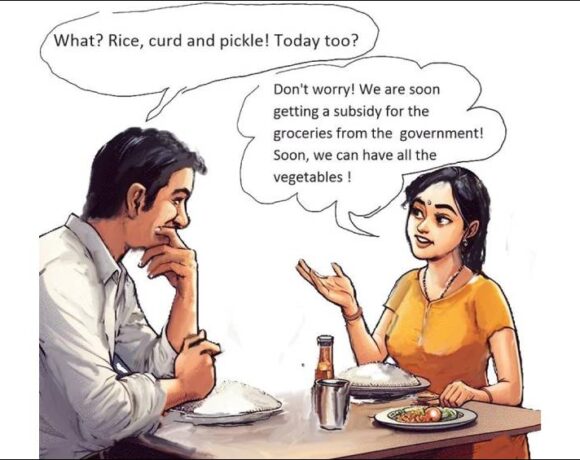An Efficient Supply Chain To Drive Growth In The Textile Value Chain

The textile industry in India is witnessing a drive to enlarge its presence in the global market, and a well-optimized logistics network plays a pivotal role in achieving this objective. In today’s highly competitive business landscape, characterized by rapidly-evolving customer expectations and global supply chain complexities, a streamlined and agile supply chain becomes imperative. An efficient logistics-backed supply chain ensures seamless flow of raw materials, effective processing and timely delivery to and from manufacturers.
“By fostering robust coordination among different stakeholders such as textile manufacturers, suppliers, distributors and retailers, it enables the industry to enhance operational efficiency and responsiveness to dynamic market demands. An optimized supply chain empowers the Indian textile industry to reduce lead times, improve inventory management and adapt swiftly to changing market dynamics. It facilitates cost-effective transportation, storage and distribution of textiles, allowing businesses to remain competitive in terms of pricing. Additionally, an efficient logistics framework supports sustainable practices, promoting eco-friendly initiatives and reducing the industry’s environmental impact,” says Vishal Barnabas, Vice President, Consumer & Manufacturing Business, Mahindra Logistics.
“The significance of an efficient logistics-backed supply chain cannot be overstated for the Indian textile trade industry’s endeavors to expand its share in the global textiles and apparel market. At Mahindra Logistics, we have vast experience in managing complex supply chains across various end-markets, and are well-poised to handle the requirements of the industry. We focus on providing integrated solutions backed by technology, ensuring operational excellence through continuous improvement initiatives. Sustainability is a key aspect of our approach, as we strive to contribute to a greener and more responsible future. Additionally, we create a supportive environment that encourages, empowers and embraces the unique differences of all our employees,” adds Barnabas.
Industry experts are of the view that since the Indian textile value chain continues to be quite fragmented, the role of efficient logistics-backed supply chain becomes more crucial. Gurudas Aras, Strategic Advisor & Independent Director, says that the domestic cotton value chain is quite complex and fragmented in nature. Cotton is grown in Gujarat, Maharashtra, Madhya Pradesh, Andhra Pradesh and Rajasthan, but 45 per cent of spindles are installed in Tamil Nadu alone. It means that cotton must travel all the way by road to mills in Tamil Nadu for conversion to yarn. Some part of the yarn then travels to different weaving centres like Ichalkaranji and Bhiwandi in Maharashtra and Surat and Ahmedabad in Gujarat.
Thereafter, the grey fabric is transported to some processing centres in the country and subsequently to garmenting centres such as Bengaluru, Mumbai, etc. This involves lot of transportation of fibres, yarns and fabrics and this adds to the logistics cost and makes the Indian textile products expensive and uncompetitive in the export markets. This challenge is common for both weaving and knitting value chains and leads up to the final products of garments and home textiles.
The story of synthetic value chain is different, but more or less along same lines, that is, adding unnecessary cost due to transportation from one place to another. The solution to this problem is to have integrated units or textile parks having all the facilities at one place. However, since respective manufacturing centres have been developed over the years, the fragmented value chain cannot be easily dismantled and hence the inherent value chain challenges will continue for the time being. Under the PLI and MITRA parks schemes, new manufacturing centres will be developed which, to some extent, will overcome the issues and challenges faced by the industry.
“When an enterprise uses efficient supply chain management, it gains an advantage in its sector by lowering the risks associated with purchasing raw materials and selling finished goods or services. The advantages of supply chain management are numerous. It reduces operational costs. The enterprise can better foresee demand and respond to it when their supply chain activities, which include resource acquisition, logistics and delivery, are systematically designed and implemented. This improves a firm’s ability to adapt to challenges, changing markets and shifting industry trends. Ultimately, all of this leads to boosting of consumer experience,” says says Rahul Mehta, past president, Clothing Manufacturers of India and director of Mumbai-based Creative Group of Companies.
“The supply chain industry is an integral part of a textile value chain and its foundation. A well-planned and effective supply chain system reduces production costs, improves business ease, enhances consumer experience and contentment and, most specifically, promotes consumption development due to increased market accessibility,” states Balkrishan Sharma, Joint President & Business Head (Spinning), Ginni Filaments Ltd.
The complexity of today’s global supply chains necessitates a data-driven solution to supply chain management. From sourcing to manufacture and distribution to the ultimate user, data-driven SCM gives end-to-end insight for controlling the information flow, products and services. “Additional aspects like efficient price controls, excellent client and supplier relations, implementing new supply chain technologies and obtaining the right logistics partners, all play a role in effective supply chain management,” adds Sharma.
Updeep Singh, President & CEO, Sutlej Textiles & Industries, believes that in the last few years, particularly post-Covid, significance of having robust supply chain has gone up multi-fold in the textile industry. In the fast fashion scenario, lead time has narrowed and time-bound delivery is something that matters in a big way. “How you manage your supply chain risk is something that assumes importance in today’s scenario when buyers are quite particular about managing their inventory in an efficient manner. Market dynamic has undergone a big transition and every stakeholder of the value chain is trying to work in a more cautious and diligent way,” avers Singh.
Sanjay Jain, Group CEO, PDS Ltd, believes that the crucial initiatives undertaken by the government to strengthen our textile and readymade garments industry are expected to deliver competitive advantage in the global landscape. The government has introduced schemes and textile parks across the country to help Indian players. These initiatives would translate into visible results only when key enablers such as best-in-class infrastructure across roads, ports and airports, strong supply chain, are fortified.
“Given that FTAs are on the horizon, it is essential for the Indian textile industry to be on an equal footing with countries that are highly dependent on the textile and ready-made garments sectors, and an efficient logistics supply chain will help ensure India to become a lucrative supply partner across industries globally,” adds Jain, whose company PDS is a global fashion infrastructure company catering to the needs to some of the world’s largest retailers and brands.
“We aspire to play a crucial role as a conduit for the Indian manufacturers to cater to the needs of retailers and brands across the world. With customers and vendor partners across the world, PDS too relies on a strong logistics supply chain. As we continue to expand our services with customer’s expertise, PDS has recently invested in Transport Partner Ltd, a Bangladesh-based provider of supply chain solutions, with a global reach through a network of exclusive agents worldwide,” informs Jain.
Anshuman Singh, Chairman & MD, Stellar Value Chain Solutions, is of the opinion that textile and apparel manufacturing supply chain – from sourcing the fibre to delivering the finished apparel to the markets – is multifaceted in nature and a number of players are involved at various levels. The demand pattern is so dynamic both in the domestic and global markets that the manufacturing process requires the backing of an agile and responsive supply chain to keep pace with the evolving demand dynamics.
“India, despite being the sixth largest exporter of textiles and apparels in the world, is facing tough challenges from countries like Bangladesh and China on the cost-competitiveness front. As the government is creating an enabling ecosystem for the textile industry to attain a $100 billion exports target by 2030 with FTA routes to capture emerging market opportunities, one shouldn’t overlook the role of an efficient supply chain in paving the way for not only accomplishing the target but also helping the textile manufacturers achieve consistent profitability,” says Singh.
“At Stellar Value Chain Solutions, we believe in co-creating integrated supply chain (warehousing and distribution) solutions and delivering agility to our customers. Given the shorter product life cycle due to the onslaught of fast fashion, we have adopted an integrated and technology-driven approach to optimise distribution processes so that companies can meet the market demands in a cost-efficient manner,” adds Singh.
Stellar Value Chain Solutions, one of the largest tech-enabled 3PL warehouse and distribution solutions provider, has added 1.5 million sq. ft. warehousing space (distribution centres) at Bhiwandi (near Mumbai) and 0.5 million sq. ft. at Banur, Punjab, thus scaling up its warehousing capacity by an additional 2 million sq. ft. in May this year. After this latest operational expansion, the total warehousing capacity of the company has risen to 16 million sq. ft. The capacity addition is primarily aimed at efficiently managing pan-India supply chain operations for a consumer durable giant. Stellar has taken over the pan-India central distribution centre operations and two regional distribution centres.
The company has plans to roll out 5 million sq. ft. of warehousing operations every year and is in the process of raising funds (primary capital) to the tune of Rs 400 crore for further growth and expansion. Stellar has also released a new RFQ of 10 million sq. ft. of total logistics space to be developed either through the BTS (Built to Suit) route or the RTM (Ready to Move) route, as the need may be, over the next two years.
Shishir Baijal, Chairman and Managing Director, Knight Frank India, says, “The warehousing market has experienced consistent growth, with transaction volumes exceeding previous year’s figures, which were already the highest in history. There has been a noticeable shift in the occupier groups within the warehousing market. Third-party logistics (3PL) providers and manufacturing companies have emerged as the primary players, indicating their increasing importance in the industry. As these occupiers take the lead, their evolving needs and preferences regarding warehousing requirements have become significant factors to consider. Occupiers have specific demands and expectations when it comes to warehousing facilities. They seek spaces that can accommodate their storage and distribution operations efficiently. Flexibility, scalability and customization options are crucial for meeting their evolving needs.”
Aditya Shah, Executive Director, V-Trans (India) Ltd & CEO, V-Xpress, says that the Indian textile industry’s success in the global market relies heavily on the efficiency of its marketing and logistics operations. With a market size of USD 145 billion approximately in 2023, the industry significantly contributes to the country’s economy and employment generation. To further expand its global market share, the industry must prioritize the development of a highly efficient logistics-backed supply chain.
India has made notable progress in its logistics sector in recent years. Valued at around USD 435 billion in 2023, the sector is expected to grow at a CAGR of over 8.36% from 2023 to 2028. Government initiatives such as PM Gati Shakti, GST, E-way bill and the establishment of dedicated freight corridors have improved transportation infrastructure and reduced logistical complexities. However, challenges like inadequate warehousing facilities, fragmented supply chains and high logistics costs still persist.
“To overcome these challenges and improve efficiency, the Indian textile industry needs to embrace modern technologies and practices. This includes utilizing digital platforms for real-time information sharing and coordination, implementing data analytics for demand forecasting and inventory management, and investing in skill development programmes to cultivate a competent workforce. Furthermore, improving connectivity, expanding warehousing facilities and optimizing transportation networks are crucial for reducing lead times and ensuring prompt product delivery,” adds Shah of V-Trans, which is a preferred single-window logistics solutions provider.
“V-Trans is equipped to address these obstacles by offering tailored logistics solutions for the textile sector. We streamline the supply chain, ensuring seamless coordination between suppliers, manufacturers and retailers. Our expertise in inventory management enables efficient handling of seasonal demand fluctuations. Additionally, we employ specialized techniques to ensure safe transportation of delicate textiles. With an extensive network and robust infrastructure, we connect brands with customers across India, even in remote areas. Customers trust V-Trans to enhance their supply chain and overcome the logistic challenges associated with delivering material,” explains Shah.















